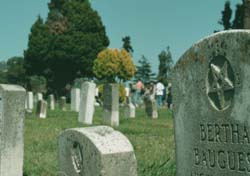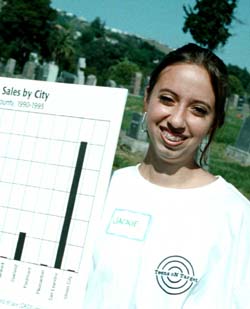| Why kids teach peace...
But if the shooting caused hardly a ripple in the news, it was a tidal wave in the lives of the boy’s family and friends, including three close friends from school, Jackie Lopez, Sylvia Hernandez, and Adrianna Maciel. "That was one experience we all shared," Lopez recalled. "And we wanted to know if we could do something to prevent other people from going through that." That drive led them to join Teens On Target, a group at Fremont High School full of young people that have gone through similar losses. Not just a support group, TNT aims to give its members the training they need to make a difference, to reach out to other young people in their community and help educate them about the forces that will shape their lives, in a state where the leading cause of death for people aged 1-19 is firearms. Teens On Target was founded in 1989 by Deane Calhoun of Oakland’s Commission on Youth Violence Prevention, a teacher and several students from Fremont High, in response to a week of particularly frequent shootings. The group says it is the nation’s first youth violence prevention advocacy program. Tamara Milagros, the program’s day to day organizer, now conducts meetings at both Fremont and nearby Castlemont high schools, both located in the so-called "killing fields" of Oakland. Very methodically and with little fanfare, TNT stands as a shining example of how a small organization can combat youth violence with a long term, public health oriented philosophy. Simply by helping inner city youths to educate their peers about the roots of urban violence, TNT makes a strong argument that this problem is something more than a matter of youthful offenders who need to be locked up. Distinguishing it from programs like DARE, which focus on educating kids about dangers like drugs and gangs, TNT tries to help teens understand the causes of violence in their communities . In the case of Lopez, Hernandez, and Maciel, perhaps, to understand why their friend was gunned down. Discussions are free-form and arise from the concerns of the student members, sometimes resembling a therapy session. On a recent afternoon, in a room off of the cafeteria at Fremont, nine students, all girls, pull their chairs into a circle, chatting about that day of school. Two boys arrive a little later. The meeting, one of three every week, starts off with a "check in," an opportunity for everyone to talk about whatever is on their mind. The issues could have come from any high school group: concerns about math assignments, finishing one’s requirements in time to graduate, getting a more racially diverse crowd at football games. "Everything’s cool up to yesterday," one girl opens gravely. "Yesterday I got two fillings in my tooth, and the doctor, he messed up one time, so he had to do it over again." They have written poems, as an assignment from an earlier meeting. After reading the poems, the discussion turns to the day’s topic. One no doubt on their minds anyway: the balance of power between the sexes. Is it all right to sleep around? What is rape, and why does it happen? Can a man be raped? Tonisha Dailey, an eleventh grader, brings up the example of her sister, who, she says, was raped while being held down by five boys. "She was twelve then," Dailey notes. Milagros, who guides the meetings, explains that she tries to make them a forum where the students can talk openly about issues like sex and rape, and just as importantly, be exposed to reliable information on these issues. "It s really important, the trust and the safety of the space," Milagros says. "They’re not allowed to put each other down; they come to be comfortable and really trust that they’ll be safe in saying what they feel." "In other forums, certain things are taboo. Here, they’ve come to trust that they won’t get into trouble if they say what they feel." The students’ experiences with violence are typically heartbreaking and heartbreakingly typical. One boy says his friend was shot in the street for wearing a red San Francisco 49ers jacket. Another tells how a friend was shot in the back of the head the week before, while playing with a gun. When asked how many of them know someone close who has been shot, all but one raise their hands. The first few weeks of meetings, (a new cycle starts every fall), focus on training the students to make presentations at area junior high schools. The student members learn statistical facts about gun violence: That the cost of a bullet is 33 cents, while the cost of a gunshot wound, in hospital bills, is around $33,000; that more Californians die every year from firearm injuries than car crashes; that two thirds of violent crimes against teens are committed by other teens. They learn how to present the information to groups. Presentations are spread out over four sessions, moving methodically through different aspects of violence and its causes. The facts could perhaps be presented more professionally by an expert on youth violence. But Dr. Vernon Henderson, a surgeon in the emergency room of Highland Hospital, who is such an expert, says that the TNT presenters are effective precisely because they are on the same level as the students they are addressing. "In most situations we have a lot of older people thinking about the problem and then dictating solutions to the younger people," Henderson says. He doesn’t believe that approach always works. "When I go into schools and talk to kids I know I’m putting myself at a disadvantage." But in the case of TNT, "we have young people going out there and advocating for violence prevention. Their view of life is different. They have their own sense of reality." Henderson, who works closely with Teens On Target and a related organization, Youth Alive, says that, though his profession gives him some respect in kids eyes, it ultimately prevents his message from getting through. He recalls one TNT student who, in a candid moment, told him why kids wouldn’t listen to him: "Because you’re a suit, man. They don’t want to listen to you, they want to hear it from us." Henderson has had much firsthand experience with not only the physical and emotional effects of youth violence, but also the long term, accumulated effects of years of rising gun violence rates, caused, as he sees it, by easy availability of guns and deepening economic inequality in the inner cities. "It s more and more of a tax on the system," he says. "Our ability to take care of [the victims of gun violence] is limited, and there are less and less resources to go around. We’re treading water as fast as we can and we’re about to drown." The surgeon believes that the only way to improve the situation is to focus on the long term, and begin to attack the problem at its roots. And that’s where groups like Teens On Target come in. "It’s very important for them to be out there," he says. For students like Jackie Lopez, TNT has served the small but important role of helping to make some difference in the community, to turn grief into a positive force. "Before I came here I didn’t know nothing," Hernandez says. "It’s made me a better person, not perfect, but better. It gives me a chance to speak out to other people I like to help them with their lives." |
Members of TNT held a
press conference at an Oakland cemetery May 8 to
draw attention to a series of killings among their peer
group. Related stories Taking their side
Teens On Target |

